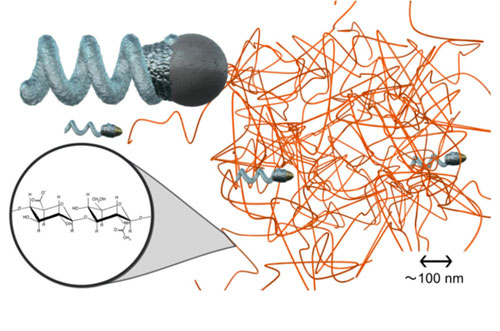| Posted: Jul 29, 2014 |
World's smallest propeller could be used for microscopic medicine
|
|
(Nanowerk News) If you thought that the most impressive news in shrinking technology these days was smart watches, think again. Scientists are quietly toiling in their laboratories to create robots that are only nanometers – billionths of a meter – in length, small enough to maneuver inside the human body and possibly inside human cells. The impact of these miraculous microscopic machines on medicine can only be imagined, but there is no doubt that it will be significant.
|
|
One of the first steps in creating these robots is figuring out how to make them move. In a paper published in the June 2014 issue of ACS Nano ("Nanopropellers and Their Actuation in Complex Viscoelastic Media"), an Israeli and German team announced that they had succeeded in creating a tiny screw-shaped propeller that can move in a gel-like fluid, mimicking the environment inside a living organism. The team is comprised of researchers from the Technion-Israel Institute of Technology's Russell Berrie Nanotechnology Institute, the Max Planck Institute for Intelligent Systems, and the Institute for Physical Chemistry at the University of Stuttgart, Germany.
|
 |
| Schematic of micro- and nanopropellers in hyaluronan gels. The polymeric mesh structure hinders the larger helices from translating effectively, whereas smaller propellers with a diameter close to the mesh size can pass through the network without being affected by the macroscopic viscoelasticity caused by the entangled polymer chains. (click on image to enlarge)
|
|
The filament that makes up the propeller, made of silica and nickel, is only 70 nanometers in diameter; the entire propeller is 400 nanometers long. (A nanometer is one billionth of a meter.) "If you compare the diameter of the [nanopropellers] with a human blood cell, then the [propellers] are 100 times smaller," said Peer Fischer, a member of the research team and head of the Micro, Nano, and Molecular Systems Lab at the Max Planck Institute for Intelligent Systems. They are so small, in fact, that their motion can be affected by the motion of nearby molecules (known as Brownian motion).
|
|
The team already knew that tiny propellers moved well through water, but to test if they could move through living organisms, they chose hyaluronan, a material that occurs throughout the human body, including the synovial fluids in joints and the vitreous humor in your eyeball. The hyaluronan gel contains a mesh of long proteins called polymers; the polymers are large enough to prevent micrometer-sized propellers from moving much at all. But the openings are large enough for nanometer-sized objects to pass through. The scientists were able to control the motion of the propellers using a relatively weak rotating magnetic field.
|
|
The findings were somewhat surprising. The team expected that they would have trouble controlling the motion of the nanopropellers, since at their size they start to be governed by diffusion, just as if they were molecules. But because the nanopropellers are the same size as the mesh in the gel, they "actually display significantly enhanced propulsion velocities, exceeding the highest speeds measured in glycerin as compared with micro-propellers, which show very low or negligible propulsion," said study co-author Associate Professor Alex Leshanksy of the Technion Faculty of Chemical Engineering.
|
|
While the nanopropellers are astonishing for their technical complexity, the real significance is how they might affect medicine. "One can now think about targeted applications, for instance in the eye where they may be moved to a precise location at the retina," says Fischer. Scientists could also attach "active molecules" to the tips of the propellers, or use the propellers to deliver tiny doses of radiation. The applications seem wide, varied, and exciting.
|

